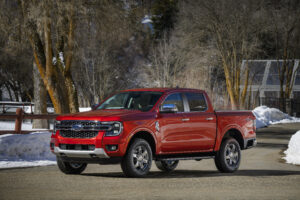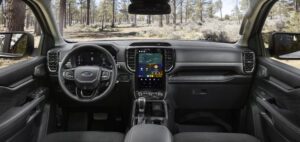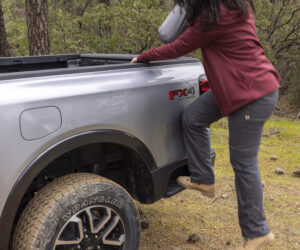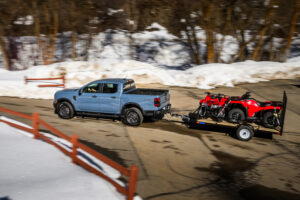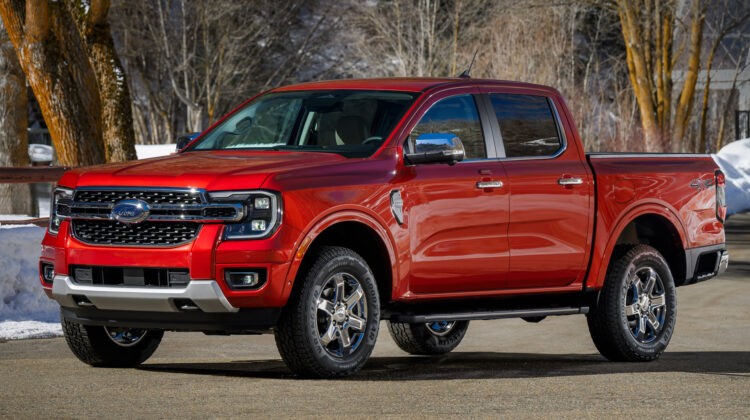
Ranger is Back Baby!
by John McElroy
Ford has a lot of catching up to do with the Ranger pickup. At least in the US market it does. Last year, sales dropped a precipitous 43%, partly thanks to a UAW strike timed to inflict maximum damage just as the new truck was getting ready to launch. Supplies dwindled so much that in February, 2024 Ford sold exactly zero Rangers.
In the meantime, GM came to market with redesigned versions of the Chevrolet Colorado and GMC Canyon, while Toyota came out with an all-new Tacoma. So Ford is woefully behind.
Even so, the all-new Ranger should bring the faithful back to the flock. It’s undergone a substantial upgrade from bumper to bumper and roof to road. The chassis is now fully boxed for more strength. The wheelbase and track are stretched and widened for a better stance and to make room for bigger engines. The rear suspension uses shocks mounted outboard of the frame rails for better ride and stability. Two AWD systems are available, part-time and full-time. And it comes with substantial electronic upgrades in the cabin. Best of all, Ford added a Raptor version for American enthusiasts (it’s already available outside the US) and more on that in a soon-to-follow-up write-up.
First impressions count for a lot and the first thing I noticed when I slid into the driver’s seat was the seat itself. It’s really comfortable, with good thigh and back support. The next thing I noticed, once I started driving, is that it has excellent cabin isolation; it’s really quiet inside. And the ride is noticeably more compliant than the outgoing Ranger and all its competitors. There’s none of that jiggling you typically get from body on frame trucks.
There are three different engines to choose from, depending on the trim level. I found the base 2.3-liter turbo to have plenty of power, even towing a 2,990-pound trailer up mountain roads, or accelerating hard up to highway speeds. Even at wide open throttle under a heavy load, the engine was not very harsh which is a good litmus test for four bangers. The optional 2.7-liter V6 is even more spirited, and then there’s the muscular 3-liter V6 in the Raptor. All of them are hooked up to a 10-speed transmission.
The reason Ford only offers one transmission is to keep the build complexity to a minimum. That’s also why the Ranger is only offered with a crew cab (4-door) with a 5-foot bed.
Speaking of the bed, owners will appreciate a step integrated into the back of the rear fender. While other trucks have steps integrated into the rear bumper that doesn’t provide as much foot room. You can actually have both feet in the Ranger’s step and since it’s on the side of the truck, you can reach into most of the bed.
Inside, there’s just what you’d expect: more storage spaces, bigger gauge clusters, and bigger screens. Ford also added Sync 4A, which uses what is called Adaptive Dash Cards instead of menus. That brings up your most-used apps at start up. There’s also a 4G modem that allows for over-the-air updates of most of the electronic systems throughout the truck. One nice non-digital touch is that the rear seat backs fold down to carry cargo that might scrape the seat covers. And of course there’s a storage bin under the back seat.
Towing has become a real product focus amongst automakers and the Ranger offers one of the best features in this regard. It’s that steering knob located on the center console that Ford calls Pro Trailer Backup Assist, and which is already available on the F-150 and Super Duty trucks. As you back up a trailer, you can control the steering with the knob as you watch what’s happening on the center screen—no need to turn around. And it works intuitively, so if you want the trailer to turn more to the left, you just turn the dial to the left, and visa versa. Novices will find it a bit of a chore to use, but it’s much simpler than trying to use the steering wheel and going through that mind-twisting challenge of steering the opposite way you want to go.
Ford raised the price of the Ranger significantly, five thousand bucks. It now starts at $32,760 but that’s about the same as a Toyota Tacoma. Sure, they did it because they knew they could get away with it. But with the success of the Maverick and customers optioning it up, I’m guessing Ford also wanted more separation in price between the two.




